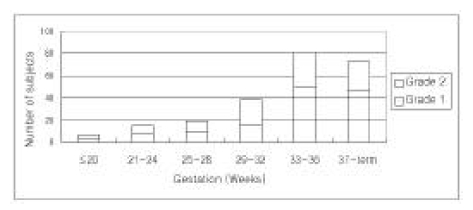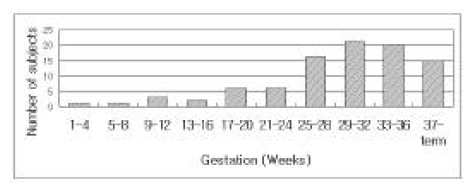Dyspnea and Palpitation during Pregnancy
Article information
Abstract
Objectives
Dyspnea and palpitation are common features of pregnancy. While several theories have been put forward to explain the etiology of gestational dyspnea and palpitation, there have been few systemic studies of its incidence, severity and time-course in a group of normal women.
Methods
We interviewed postpartum women, within 3 days after delivery, about dyspnea and palpitation. Separately from this interview, we performed 24-hour ECG monitoring for obstetric patients with palpitation before delivery.
Results
The subjects interviewed were 261 women, of whom 37.5 percent and 11.5 percent experienced dyspnea and palpitation, respectively. These symptoms had a tendency to increase to term. The presence of arrhythmias could be documented in only 22% of patients having 24-hour Holter monitoring.
Conclusion
Dyspnea and palpitation were common among normal pregnant women and had a tendency to increase to term.
INTRODUCTION
Dyspnea is a common feature of pregnancy. Although usually it is not of sufficient magnitude to be of clinical importance, it occasionally is severe enough to be disabling to the patient and puzzling to the physician; it may pose a difficult diagnostic problem in the patient with known or suspected heart disease. Some pregnant women also complain of the uncomfortable awareness of a beating heart-palpitation. In fact, the symptoms are common cardio-respiratory reasons for referral to the cardiologic or pulmonary clinic during pregnancy.
While several theories have been put forward to explain the etiology of gestational dyspnea1–11) and palpitation12, 13), there have been few systemic studies of its incidence, severity and time-course in a group of normal women7, 13). Such information would not only be of value in the investigation of the cause of these symptoms in pregnancy, but would also be helpful in the management of patients with pre-existing cardiorespiratory disease who become pregnant.
MATERIALS AND METHODS
We interviewed women within their third postpartum day who had no previous history of cardio-respiratory disease, had a normal singleton pregnancy and had developed no obstetric complication, such as preeclampsia. Women having dyspnea from a non-pregnant state or cigarette smokers were excluded. Patients who already had supraventricular tachycardia, Wolff-Parkinson-White syndrome, atrial fibrillation, and ventricular tachycardia were also excluded from this study.
The onset, severity and time-course of dyspnea and palpitation were asked during the interview.
The degree of dyspnea was carefully elicited using a modification of the Medical Research Council questionnaire on respiratory symptoms7). The following were the grades of dyspnea into which symptoms were classified; Grade 1: dyspnea present on climbing hills or more than one flight of stairs, Grade 2: dyspnea present (a) on climbing one flight of stairs, (b) walking at an even pace on level ground, (c) during routine performance of housework, Grade 3: dyspnea on slightest exertion or at rest. Other respiratory symptoms, such as cough and sputum production suggesting respiratory disease, were also elicited and they were excluded from analysis of this study.
Separately from this interview, we performed 24-hour ECG monitoring for obstetric patients with palpitation before delivery.
RESULTS
The subjects interviewed were 261 women whose ages ranged from 22 to 42 years (mean 30±3). Cardio-respiratory examination was normal in all the subjects. Figure 1 shows the numbers of subjects who experienced dyspnea during pregnancy. These were further divided according to the different grades of dyspnea.

Incidence, severity and time-course of dyspnea during pregnancy. There is a steady increase in the number of subjects with dyspnea until the period between 33 to 36 weeks gestation when 37.5 percent of the group admit to the symptom.
It can be seen that before 20 weeks gestation, there were subjects who experienced dyspnea, even though not many (3.2%). From this stage of pregnancy, there is a steady increase in the number of subjects with dyspnea until the period between 33 to 36 weeks gestation when 37.5 percent of the group admitted to the symptom. After this period, there was no further increase.
The percentage of subjects who experienced palpitation during pregnancy was 11.5% (30 out of 261). From the early stage of pregnancy, there was a steady increase in the percentage of subjects with palpitation until the term.
Among 22 patients having 24-hour Holter monitorings, eighteen experienced palpitations during the test. The presence of arrhythmia was, however, documented just in four patients (22%) and the arrhythmias were ventricular premature beats (VPB’s), atrial premature beats (APB’s) and sinus tachycardia.
DISCUSSION
Dyspnea is common during normal pregnancy. About half of women with no history of cardio-respiratory disease have been reported to experience dyspnea before the 19 week of gestation and 76% complain of this symptom by the 31 week7). However, our study showed there were not many women who complained of it as in the previous study7). The information was obtained retrospectively depending on recall, so dyspnea which was not serious enough to interfere with daily life may have been denied, and it may also be due to the fact that dyspnea improves as term approaches and seldom, if ever, complicates the delivery. In any event, dyspnea is quite often overshadowed by the more urgent symptom of pain at that time, and it seldom interferes with daily life9). Finally, when the patient returns for her postpartum examination, the dyspnea has vanished. These considerations can explain the discrepancy that exists between the results from our study and a previous prospective interview study7).
The mechanism of dyspnea in pregnancy is controversial. Initially, breathlessness was attributed to an increased mechanical load by chest wall distortion from the gravid uterus1–3). However, dyspnea can begin before any upward displacement of the diaphragm, suggesting that factors other than mechanical pressure may be involved4). Other studies support that physiologic dyspnea is due to a change in perception of normal respiration5, 6). Finally, dyspnea probably results from the subjective awareness of hyperventilation that is universally present in pregnancy5, 7). Hyperventilation in pregnancy is predominantly due to an increase in the depth of the tidal volume, with little change in the respiratory rate8, 9). It appears that women who experience dyspnea are aware of this change in their ventilatory pattern. The mechanism of hyperventilation responsible for the sensation of dyspnea is not clear but is attributed to the effect of progesterone on respiratory neural drive10) or increased chemosensitivity to CO2 and hypoxia11). However, considering that the incidences are different in each of the studies, psychological, environmental and sociological factors may play a significant role in this complaint.
This study demonstrates a high incidence of gestational palpitation which increased while pregnancy approached to term. Our Holter findings, however, failed to show a positive relation between symptom and arrhythmias, even though they were obtained from different subjects. The presence of arrhythmias could be documented in only 22% of patients having 24-hour Holter monitoring.
Clinical experience and published information, mostly anecdotal, have suggested an increased incidence of cardiac arrhythmias during pregnancy14–16). One study13) demonstrates a high incidence of ectopic activity in normal healthy patients presenting with symptoms, mostly palpitations, during gestation. Twenty percent of these patients were found to have > 10 VPB’s. A significant reduction in the incidence of ectopic activity in a subgroup of these patients, in whom Holter monitoring was repeated postpartum, clearly demonstrated the arrhythmogenic effect of pregnancy.
Increased sympathetic activity during pregnancy has been proposed as a mechanism for increased incidence of arrhythmias12) and could be related to symptoms, such as palpitation. Such mechanism, however, is not supported by the catecholamine levels which have been reported to be either the same or even lower in pregnancy when compared with the nonpregnant state17, 18). The cause for symptoms in most cases remains, therefore, unclear and their presence is not predictive of cardiac arrhythmia. A common sensation of palpitation in the absence of concomitant cardiac arrythmias may also be related to physiologic changes occurring during pregnancy, such as increased heart rate, decreased peripheral resistance and increased stroke volume19).
In conclusion, dyspnea and palpitation are common and have a tendency to increase up to 37.5% and 11.5%, respectively, toward term but the incidence of dyspnea was not so high as other studies showed.
